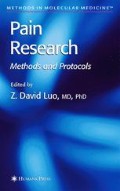Abstract
Since its introduction in 1992, the spinal nerve ligation (SNL) model of neuropathic pain has been widely used for various investigative works on neuropathic pain mechanisms as well as in screening tests for the development of new analgesic drugs. This model was developed by tightly ligating one (L5) or two (L5 and L6) segmental spinal nerves in the rat. The operation results in long-lasting behavioral signs of mechanical allodynia, heat hyperalgesia, cold allodynia, and ongoing pain. In the process of widespread usage, however, many different variations of the SNL model have been produced, either intentionally or unintentionally, by different investigators. Although the factors that cause these variations themselves are interesting and important topics to be studied, the pain mechanisms involved in these variations are likely different from the original model. Therefore, this chapter describes, in detail, the method for producing the spinal nerve ligation model that will minimally induce potential factors that may contribute to these variations. It is hoped that this description will help many investigators to produce a consistent animal model with uniform pathophysiological mechanisms.
Access this chapter
Tax calculation will be finalised at checkout
Purchases are for personal use only
References
Kim, S. H. and Chung, J. M. (1992) An experimental model for peripheral neuropathy produced by segmental spinal nerve ligation in the rat. Pain 50, 355–363.
Choi, Y., Yoon, Y. W., Na, H. S., et al. (1994) Behavioral signs of ongoing pain and cold allodynia in a rat model of neuropathic pain. Pain 59, 369–376.
Chaplan, S. R., Bach, F. W., Pogrel, J. W., et al. (1994) Quantitative assessment of tactile allodynia in the rat paw. J. Neurosci. Methods 53, 55–63.
Kim, S. H. and Chung, J. M. (1991) Sympathectomy alleviates mechanical allodynia in an experimental animal model for neuropathy in the rat. Neurosci. Lett. 134, 131–134.
Park, S. K., Chung, K., and Chung, J. M. (2000) Effects of purinergic and adrenergic antagonists in a rat model of painful peripheral neuropathy. Pain 87, 171–179.
Leem, J. W., Willis, W. D., and Chung, J. M. (1993) Cutaneous sensory receptors in the rat foot. J. Neurophysiol. 69, 1684–1699.
Xie, J., Yoon, Y. W., Yom, S. S., and Chung, J. M. (1995) Norepinephrine rekindles mechanical allodynia in sympathectomized neuropathic rat. Analgesia 1, 107–113.
Chung, J. M., Choi, Y., Yoon, Y. W., and Na, H. S. (1995) Effects of age on behavioral signs of neuropathic pain in an experimental rat model. Neurosci. Lett. 183, 54–57.
Yoon, Y. W., Lee, D. H., Lee, B. H., et al. (1999) Different strains and substrains of rats show different levels of neuropathic pain behaviors. Exp. Brain Res. 129, 167–171.
Lee, D. H., Chung, K., and Chung, J. M. (1997) Strain differences in adrenergic sensitivity of neuropathic pain behaviors in an experimental rat model. NeuroReport 8, 3453–3456.
Shir, Y., Ratner, A., Raja, S. N., Campbell, J. N., and Seltzer, Z. (1998) Neuropathic pain following partial nerve injury in rats is suppressed by dietary soy. Neurosci. Lett. 240, 73–76.
Burton, A. W., Lee, D. H., Saab, C., and Chung, J. M. (1999) Preemptive intrathecal ketamine injection produces a long-lasting decrease in neuropathic pain behaviors in a rat model. Reg Anesth. Pain Med. 24, 208–213.
Mao, J., Price, D. D., Mayer, D. J., et al. (1992) Intrathecal MK-801 and local nerve anesthesia synergistically reduce nociceptive behaviors in rats with experimental peripheral mononeuropathy. Brain Res. 576, 254–262.
Mao, J., Price, D. D., Hayes, R. L., et al. (1993) Intrathecal treatment with dextrorphan or ketamine potently reduces pain-related behaviors in a rat model of peripheral mononeuropathy. Brain Res. 605, 164–168.
Sheen, K. and Chung, J. M. (1993) Signs of neuropathic pain depend on signals from injured nerve fibers in a rat model. Brain Res. 610, 62–68.
Dixon, W. J. (1980) Efficient analysis of experimental observations. Ann. Rev. Phar. Tox. 20, 441–462.
Author information
Authors and Affiliations
Editor information
Editors and Affiliations
Rights and permissions
Copyright information
© 2004 Humana Press Inc.
About this protocol
Cite this protocol
Chung, J.M., Kim, H.K., Chung, K. (2004). Segmental Spinal Nerve Ligation Model of Neuropathic Pain. In: Luo, Z.D. (eds) Pain Research. Methods in Molecular Medicine, vol 99. Humana Press. https://doi.org/10.1385/1-59259-770-X:203
Download citation
DOI: https://doi.org/10.1385/1-59259-770-X:203
Publisher Name: Humana Press
Print ISBN: 978-1-58829-103-5
Online ISBN: 978-1-59259-770-3
eBook Packages: Springer Protocols

